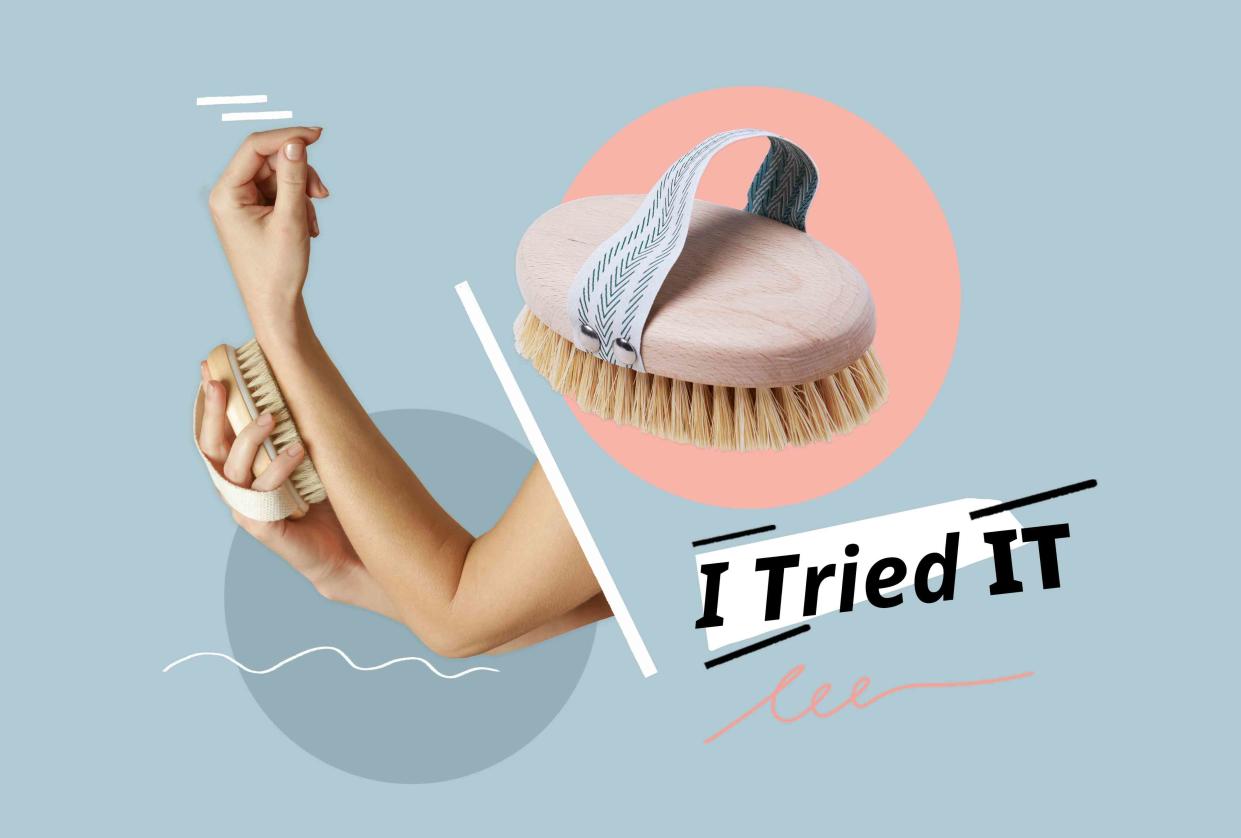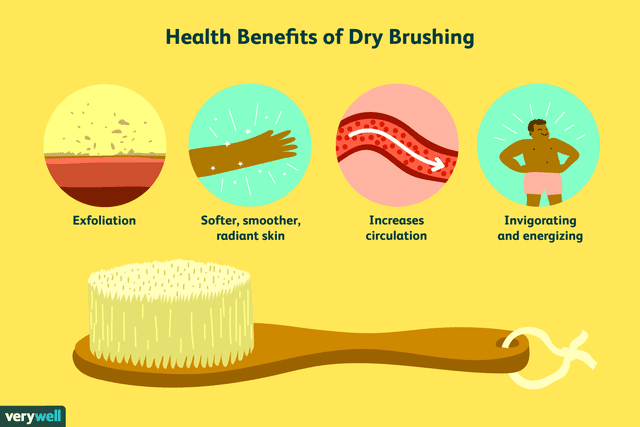I Tried Dry Brushing and I'm Not Going Back to Exfoliating Scrub

Photo Illustration by Michela Buttignol for Verywell Health; Getty Images
Dry brushing is an ancient technique that involves exfoliating the skin with a bristled brush.
Some social media users claim dry brushing can improve circulation, stimulate lymphatic drainage, and eliminate cellulite.
Wetting the skin before dry brushing can reduce abrasiveness. And moisturizing afterward can protect the skin barrier and boost hydration.
The first time I tried dry brushing, I watched a faint dusting of dry skin slough off my forearm. After showering and slathering myself in lotion, I felt the smoothness of my skin and knew I’d found a new favorite routine.
“Dry brushing” describes the practice of using a bristled brush to manually exfoliate the skin, usually before taking a shower or bath. The practice has been around for thousands of years—the ancient Romans, Japanese, Korean, and Indian communities all practiced some version of exfoliative brushing.
Proponents of dry brushing are rampant on social media, claiming it can help improve circulation, boost energy, help clear toxins from the body, and make skin more luminous.
For all the apparent health benefits, I was most interested in trying a new exfoliant. I’ve lived with keratosis pilaris on my upper arms for as long as I can remember. I use an exfoliating scrub a few times a week and moisturize my arms with an exfoliating lotion in attempts to keep my bumpy skin in check.
That routine works pretty well for me, but I feel a pang of guilt every time I reach for the exfoliating scrub. I use a product that claims not to contain plastic microbeads. Still, I can’t help but wonder whether sea critters can stomach the coarse little bits I wash down the drain with each shower.
Dry brushing, if nothing else, is a seemingly environmentally sound way to exfoliate the body.

Illustration by JR Bee, Verywell
How to Dry Brush
During my first few brushes, I scrubbed my skin when it was totally dry and hurried the routine so I’d finish by the time the shower was running warm. Then, one night, I lit some candles, played some relaxing music, and took my sweet time with the brush. It made all the difference.
The name “drying brushing” suggests you should brush on completely dry skin, but using a dollop of essential or olive oil can minimize the abrasiveness, according to Ivy Lee, MD, a board-certified dermatologist at Pasadena Premier Dermatology. Lee said she recommends showering to moisten the skin first, and exfoliate when the skin is still slightly damp.
Dry brushes differ mostly in the shape and length of the handles. Some are made with natural bristles while others are synthetic. They can sell for more than $100, but most aren’t nearly that expensive—mine cost $9 at Walgreens.
Related:Natural Remedies for Back Acne
The brushing itself is pretty straightforward—simply buff your skin using long circular motions. First-timers should be extra gentle. Some areas of the body, like the ankles and elbows, are rougher and can stand more persistent brushing, while others are more sensitive.
“I would recommend starting with very gentle pressure for only thirty seconds at a time [per area], two to three times per week,” said Hadley King, MD, a clinical instructor of dermatology at Weill Medical College of Cornell University. “Depending on how your skin is reacting you can slowly increase to up to three minutes at a time once daily.”
Lee recommends dry brushing only once a week to once every two weeks. Brushing too frequently or too aggressively may cause harmful irritations and abrasions.
“The tough thing is we live in a culture where moderation can be hard. And we think gosh, the more intense it is, the deeper we go, the harder we go, the more benefits we will get,” Lee said.
It’s important to moisturize your skin after a dry brush routine to help reintroduce hydration after disrupting the skin barrier. Using lotion when the skin is still damp will help it to sop up the extra moisture.
What Are the Benefits of Dry Brushing?
The main function of manual exfoliation is to make the skin smoother and, by effect, more luminous and healthy.
“Gentle dry brushing will help to remove dead skin cells and reveal a brighter complexion. Over time exfoliation can speed up cell turnover and help minimize some of the effects of aging,” King said.
Some influencers claim that dry brushing can improve circulation, promote lymphatic drainage, and reduce the appearance of cellulite. Lee said there’s not a ton of evidence on these benefits, but the effect on circulation is intuitive.
Related:How the Lymphatic System Works
“If you think about it from just the process of the manual exfoliation, you’re causing these micro-abrasions and micro trauma to the skin. And you’re applying pressure, so there’s an element of massage as well,” Lee said. “That is certainly going to bring increased circulation to the area, as it would any type of minor or major trauma.”
Some say that manually stimulating lymph movement by dry brushing up the leg and down the arms towards the heart can get lymph fluid to flow to the nodes. Doing so could help clear toxins from the body. While there’s no solid evidence to support this works for a standard dry brush session, Lee said it’s not out of the question that someone could essentially perform a lymphatic massage using the brush to get a similar effect.
King said that dry brushing won’t get rid of cellulite or scar tissue. By improving blood flow to the area, brushing can plump the skin, which can make cellulite appear less visible, but the effect is only temporary.
Related:How Does Skin Cycling Work?
Are There Any Risks to Dry Brushing?
It’s wise to clean one’s brush daily, King said, as skin cells can accumulate and become a “breeding ground for bacteria and yeast.” Regular cleaning can make one brush last for months.
Dry brushing isn’t for everyone. Manual exfoliation can exacerbate eczema, psoriasis, and other serious skin conditions. People with rosacea-prone skin may experience irritation and flares with even gentle dry brushing, King said.
It’s best to consult a dermatologist if you have an existing skin condition that could be exacerbated with dry brushing, or if you notice irritation after brushing. And avoid brushing open sores or any areas of the skin that are scratched or inflamed.
Manual exfoliation also isn’t necessarily best for all parts of the body. For instance, Lee strongly advises against brushing the face, opting instead for a chemical exfoliant like an alpha-hydroxy acid (AHA) or beta-hydroxy acid (BHA).
Related:Exfoliation Tips to Help Acne-Prone Skin
“Something you would use for dry brushing say, your elbows and knees or feet, would be way too much and way too aggressive for your face or your neck right areas that are super sensitive and have thinner skin,” Lee said.
A moisturizer with chemical exfoliants like salicylic acid and lactic acid can help smooth particularly rough patches on the body too, including my KP-studded arms.
Starting with gentle brushing and soothing moisturizers, and keeping tabs on how your skin responds is key to making dry brushing a restorative process, rather than a painful one.
“Our skin is our natural barrier to the outside world. It’s meant to protect us from bacteria, fungi, viruses, and outside trauma,” Lee said. “We want to make sure that we’re not being too aggressive to disrupt that.”
Read Next:Will an Acne Scrub Clear Your Skin?
Dry brushing has absolutely found a place in my evening self-care routine. There aren’t that many proven health benefits to the practice besides exfoliation. But it’s inexpensive, soothing, and leaves my skin feeling smooth and refreshed.

